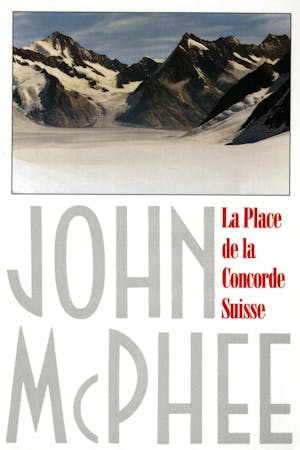Place de la Concorde Suisse, La
The Swiss have not fought a war for nearly five hundred years, and are determined to know how so as not to.
In Italy, it has been said of the Swiss Army, "I didn't know they had one." When the Italian learns that the Swiss Army vastly outnumbers Italy's, the Italian says, "That is not difficult."
The Swiss Army has served as a model for less languid nations. The Israeli Army is a copy of the Swiss Army.
Switzerland is two times the size of New Jersey. New Jersey, by far, has the larger population. Nonetheless, there are six hundred and fifty thousand people in the Swiss Army. At any given time, most of them are walking around in street clothes or in blue from the collar down. They are a civilian army, a trained and practiced militia, ever ready to mobilize. They serve for thirty years. All six hundred and fifty thousand are preparedto be present at mobilization points and battle stations in considerably less than forty-eight hours.
If you understand the New York Yacht Club, the Cosmos Club, the Metropolitan Club, the Century Club, the Piedmont Driving Club, you would understand the Swiss Army.
Some of these thoughts run through my mind as the Section de Renseignements--of the Eighth Battalion of the Fifth Regiment of the Tenth Mountain Division --gets ready to patrol a sector of the uppermost Rhone. The battalion has been told to move, and it is the business of these soldiers to learn as thoroughly and as rapidly as they can what their major needs to know about the new sector; for example, how many troops will fit in a cable car to the Riederalp? Where is a good site for a command post on the lower declivities of the alp above Lax? How many soldiers could sleep in the Schwarzenbach barn? Would that be all right with Schwarzenbach? Have explosives already been installed--as is the case at thousands of strategic points in Switzerland--to blow up the Nussbaum bridge?
With notebooks and pencils, the patrols of the Section de Renseignements go from place to place exploring, asking questions, collecting particulars, scribbling information, characterizing and describing people and scenes, doing reconnaissance of various terrains, doing surveillance of present activity, and tracking events of the recent past. Afterward, they trudge back and, under pressure of time, compress, arrange, and present what they have heard and seen. All of that is incorporated into the substance of the word "renseignements."
I have limitless empathy for the Section de Renseignements.The leader of the second patrol today is Luc Massy, who entered the army ten years ago with essentially his present status. He is five feet eleven inches tall, with blond hair and an aquiline nose--trim, irreverent, thirty years old. The others are Jean-Bruno Wettstein, Denis Schyrr, Pierre Pera, Jean Reidenbach. Each wears boots, gaiters, a mountain jacket, and a woolly-earflap Finnish hat, and carries a fusil d'assaut, which can fire twenty-four bullets in eight seconds and, with added onomatopoeia, is also know as a Sturmgewehr. Massy wears hobnailed boots. Most of the other soldiers are younger, and when they came into the army were issued boots with rubber soles--Swiss crosses protruding from the soles in lieu of hobnails. Massy says he feels the north wind, and therefore the weather will be stable for three, six, or nine days. The air seems still to me--a clear and frosted morning at the end of October in a deep valley under Alps freshly dusted with snow. Using pocket calculators and topographic maps, the patrol has charted its assignments--uphil, down, up, down--figuring that eleven hours will be required to complete them. Accordingly, each man puts in his pack a plastic sack of lunch and a plastic sack of dinner--dried fruit, fresh fruit, bread, cheese, pate, sausage, and bars that are labelled "Militärschokolade, Chocolat Militaire."
Copyright © 1983, 1984 by John McPhee





